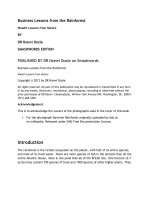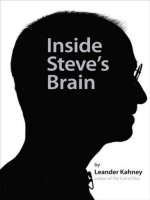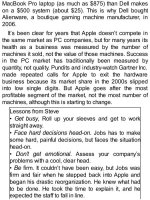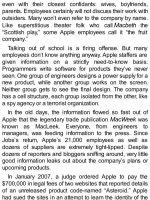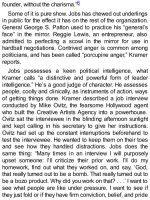Inside Steve''''s Brain Business Lessons from Steve Jobs, the Man Who Saved Apple by Leander Kahney_7 doc
Bạn đang xem bản rút gọn của tài liệu. Xem và tải ngay bản đầy đủ của tài liệu tại đây (152.5 KB, 25 trang )
even with their closest confidants: wives, boyfriends,
parents. Employees certainly will not discuss their work with
outsiders. Many won’t even refer to the company by name.
Like superstitious theater folk who call Macbeth the
“Scottish play,” some Apple employees call it “the fruit
company.”
Talking out of school is a firing offense. But many
employees don’t know anything anyway. Apple staffers are
given information on a strictly need-to-know basis.
Programmers write software for products they’ve never
seen. One group of engineers designs a power supply for a
new product, while another group works on the screen.
Neither group gets to see the final design. The company
has a cell structure, each group isolated from the other, like
a spy agency or a terrorist organization.
In the old days, the information flowed so fast out of
Apple that the legendary trade publication MacWeek was
known as MacLeek. Everyone, from engineers to
managers, was feeding information to the press. Since
Jobs’s return, Apple’s 21,000 employees as well as
dozens of suppliers are extremely tight-lipped. Despite
dozens of reporters and bloggers sniffing around, very little
good information leaks out about the company’s plans or
upcoming products.
In January 2007, a judge ordered Apple to pay the
$700,000 in legal fees of two websites that reported details
of an unreleased product code-named “Asteroid.” Apple
had sued the sites in an attempt to learn the identity of the
had sued the sites in an attempt to learn the identity of the
person in its ranks who leaked the information, but lost the
case.
Some speculated that Jobs sued the websites to keep
the press in line. The lawsuit was seen as press
intimidation, a scare tactic designed to intimidate the press
from reporting rumors. Much of the public discussion
concerned press freedom and whether bloggers have the
same rights as professional reporters, who enjoy some
protection under laws that shield journalists. This is why the
Electronic Frontier Foundation took on the case and turned
it into a cause célèbre—to protect press freedom. But from
Jobs’s point of view, the case had nothing to do with press
freedom. He sued the bloggers to scare the shit out of his
own employees. He was less concerned with gagging the
press than gagging staff who leaked to the press— and
anyone who might think of doing it in the future. Apple’s
buzz marketing is worth hundreds of millions of dollars, and
Jobs wanted to check the leaks.
Some of Jobs’s secrecy measures get a little extreme.
When Jobs hired Ron Johnson from Target to head up
Apple’s retail effort, he asked him to use an alias for
several months lest anyone get wind that Apple was
planning to open retail stores. Johnson was listed on
Apple’s phone directory under a false name, which he used
to check into hotels.
Apple’s head of marketing, Phil Schiller, said he’s not
allowed to tell his wife or kids what he’s working on. His
teenage son, an avid iPod fan, was desperate to know
what his dad was cooking up at work, but Daddy had to
keep his trap shut lest he get canned. Even Jobs himself is
subject to his own strictures: he took an iPod hi-fi boombox
home for testing, but kept it covered with a black cloth. And
he listened to it only when no one else was around.
Apple’s obsessive secrecy is not a quirk of Jobs’s
control-freak tendencies; it’s a key element of Apple’s
extremely effective marketing machine. Apple makes
millions of dollars in free advertising every time Jobs steps
onto a stage to reveal a new product. Many have wondered
why there are no bloggers at Apple. It’s because loose lips
at Apple sink ships. But there are dozens of bloggers at
Pixar, even before Jobs sold Pixar to Disney. Pixar
bloggers happily gossip about all aspects of Pixar’s
projects and their work lives. The difference is that Pixar’s
movies don’t rely on a surprise unveiling to get press. New
movies are routinely reported in the Hollywood trade press.
Jobs isn’t a control freak for the sake of it; there’s a method
to his madness.
Personality Plus
Jobs has been very successful at creating a persona for
Apple. Through advertising, he has shown the public the
things he, and Apple, stands for. In the late 1970s, it was
revolution through technology. Later it was about being
creative, thinking different. Jobs’s personality allows Apple
to market itself as human, and cool. His personality is the
raw material of Apple’s advertising. Even an agency like
Chiat/Day could never ever make Bill Gates look cool.
Apple’s advertising has done a good job at conveying
the company as an icon of change, of revolution, and of
bold thinking. But it does so in a subtle, indirect way. Apple
rarely brags. It never says, “We’re revolutionary. Really.” It
uses the storytelling of its advertising to convey this
message, often as a sub-text.
Take the iPod silhouette ads. The imagery of the
campaign was fresh and new; it didn’t look like anything
that came before. “They always have this freshness in
graphic design. The look is very simple and very iconic. It’s
so distinctive that it has a look to itself,” advertisng
journalist Warren Berger, author of Advertising Today and
Hoopla, told me in a telephone interview.
25
Berger said the best way to get creative advertising is to
hire the most creative agency. Chiat/Day is one of a handful
of the most creative agencies in the world, but the real trick
is to communicate what the brand is about. “Lee Clow and
Jobs understood each other so well, they became
buddies,” said Berger. “Clow really got the culture of Apple,
the mind-set. He really understood what they were trying to
do. And Jobs gave Clow total creative freedom. He allowed
Clow to show him anything no matter how crazy it might
seem. It really allows people to push the boundaries. IBM
could never do that. They would never give Chiat/Day the
freedom that Jobs gave them.”
In 2006, Hewlett-Packard started to do very good
advertising, with campaigns that featured people, not
computers, in spots that looked like they may have come
from Apple. In one of HP’s “The Computer Is Personal
Again” TV spots, the hip-hop star Jay Z shows viewers the
contents of his computer, which is conjured up as a 3D
special effect between his gesticulating hands. His face is
never shown.
Hewlett-Packard hired Goodby Silverstein, another
superstar agency. The ads were interesting and very well
done, but they never had the strength of personality of
Apple’s ads, because the company doesn’t have the
strength of personality. No matter how the ads tried to
personalize HP the corporation through celebrities like Jay
Z, it still felt like a company. Apple is more of a
phenomenon than a company. Hewlett-Packard can never
be quite as magical because it doesn’t have a personality.
The same thing happened to Apple when Jobs left in 1985.
“When Steve left, Apple became a company again,” said
Berger. “The advertising was good, but it didn’t have that
magic. It didn’t look like the same company. It wasn’t a
phenomenon. It didn’t feel like a revolution. It was just trying
to stabilize things.”
Between the big, bold, brand-building campaigns, like
“Think Different” and the iPod silhouettes, Apple mixes in
more traditional product advertising. These product
promotions focus on specific products, like the “I’m a
Mac/I’m a PC” campaign, which dramatized why it makes
sense to buy an Apple computer.
The campaigns represented the rival Mac and Windows
platforms as two people. Up-and-coming actor Justin Long
personified the effortlessly cool Mac, while comedian and
author John Hodgeman represented the nerdy, accident-
prone PC. In one spot, Hodgeman has a cold. He’s
contracted a virus. He offers Long, the Mac, a
handkerchief, which he politely declines because Macs are
largely immune to computer viruses. In thirty seconds, the
spot cleverly and economically conveyed a message about
computer viruses. The ads create a memorable, dramatic
situation—more so than HP’s individuals showing the
contents of their computer.
Like “Think Different,” the campaign had a big impact. It
enjoyed a high profile and was widely parodied—a good
measure of a campaign’s cultural impact.
“They create this stuff that gets into the culture,” said
Berger. “Soon enough people are talking about it, and he
gets into others’ advertising. You see the same layouts, the
same motifs, in other ads, in magazine and newspaper
layouts. There’s a whole graphic design look; suddenly
other advertisers have embraced it. The ‘Think Different’
posters. People put them on their wall. That’s really
successful advertising. The ads became a phenomenon.
You didn’t have to pay people to pass it around.”
Not everyone loves Apple’s advertising. Seth Godin,
author of several best-sellers about marketing, said
Apple’s advertising has often been mediocre. “I’m
underwhelmed by most of Apple’s advertising,” he told me
by phone from his office in New York. “It’s not been
effective. Apple’s advertising is more about pandering to
the insiders than acquiring new users. If you have a Mac,
you love Apple’s advertising because it says ‘I’m smarter
than you.’ If you don’t have a Mac it says ‘you’re stupid.’ ”
26
The “I’m a Mac/I’m a PC” ads have been described as
unbearable smug. Many critics couldn’t stand Justin Long’s
self-consciously hip Mac character, who had the poise and
self-assurance that annoys some people. The stubble and
a casual hoodie added to the irritation. Many in the target
audience identified more with Hodgeman’s nebbish PC
character, who was endearingly bumbling.
“I hate Macs,” wrote British comedian Charlie Booker in
a critique of the ads. “I have always hated Macs. I hate
people who use Macs. I even hate people who don’t use
Macs but sometimes wish they did PCs have charm;
Macs ooze pretension. When I sit down to use a Mac, the
first thing I think is, ‘I hate Macs’, and then I think, ‘Why has
this rubbish aspirational ornament only got one mouse
button?’ ”
Booker said the campaign’s biggest problem is that it
“perpetuates the notion that consumers somehow ‘define
themselves’ with the technology they choose.”
He continues, “If you truly believe you need to pick a
mobile phone that ‘says something’ about your personality,
don’t bother. You don’t have a personality. A mental illness,
maybe— but not a personality.”
27
Conversely, the “Switchers” campaign, which ran in the
early 2000s, was ripped for portraying Apple customers as
losers. The campaign, shot by Oscar-winning
documentarian Errol Morris, featured a series of ordinary
people who had recently switched from Windows
computers to Macs. Looking straight into Morris’s camera,
they explained the reasons they switched, the problems
they had been having with Windows, and rhapsodized their
new love affair with the Mac. Trouble was, most seemed
like they were running away from their problems. They
couldn’t cope, and they had given up.
“Apple couldn’t have picked a starker collection of life’s
losers with which to promote the Macintosh,” wrote
journalist Andrew Orlowski.
28
“The message is a mass of
conflicting signals. Having portrayed the Mac as the
computer for over-achievers, it’s now suggesting that it’s a
kind of refugee camp for life’s most bitter losers.”
The “Think Different” campaign was criticized for using
noncommercial figures, people who patently didn’t believe
in commercial culture. It even included committed
nonmaterialists like Gandhi and the Dalai Lama, who
actively opposed commercialism. These figures would
never endorse a product in a commercial—and here Apple
was using them to endorse products. A lot of critics couldn’t
believe Apple’s chutzpah and thought the company had
stepped over the line.
stepped over the line.
In Apple’s defense, Clow told the New York Times that
Apple intended to honor the subjects of the campaign, not
exploit them. “We’re not trying to say these people use
Apple, or that if they could’ve used a computer, they
would’ve used Apple. Instead, we’re going for the
emotional celebration of creativity, which should always be
part of how we speak about the brand.”
29
Allen Olivio, an Apple spokesperson at the time, said:
“We would never associate these people with any product;
it’s Apple celebrating them versus Apple using them. To
say that Albert Einstein would have used a computer would
cross the line. Why would he need one? But it’s different to
say he looked at the world differently.”
30
Berger, the ad critic, said he loved the “Think Different”
campaign. “American culture is very commercial. This stuff
gets jumbled up. Quentin Tarantino talks about Burger
King. Apple makes a poster of Rosa Parks. That’s our
culture. People are free to use anything from wherever they
want.”
Lessons from Steve:
• Partner only with A players and fire bozos.
Talented staff are a competitive advantage that puts
you ahead of your rivals.
• Seek out the highest quality—in people, products,
and advertising.
• Invest in people. When Jobs axed products after
returning to Apple, he “steved” a lot of projects, but he
kept the best people.
• Work in small teams. Jobs doesn’t like teams of
more than one hundred members, lest they became
unfocused and unmanageable.
• Don’t listen to "yes” men. Argument and debate
foster creative thinking. Jobs wants partners who
challenge his ideas.
• Engage in intellectual combat. Jobs makes
decisions by fighting about ideas. It’s hard and
demanding, but rigorous and effective.
• Let your partners be free. Jobs gives his creative
partners a lot of rope.
Chapter 5
Passion: Putting a Ding in the Universe
“I want to put a ding in the universe.”
—Steve Jobs
At every turn of his career, Steve Jobs has inspired
employees, lured software developers, and snagged
customers by invoking a higher calling. For Jobs,
programmers don’t work to make easy-to-use software;
they’re striving to change the world. Apple’s customers
don’t buy Macs to work on spreadsheets; they’re making a
moral choice against the evil monopoly of Microsoft.
Take the iPod. It’s a cool MP3 player. It’s a great blend of
hardware, software, and online services. It’s driving Apple’s
comeback. But for Jobs, it’s primarily about enriching
people’s lives with music. As he told Rolling Stone in
2003: “We were very lucky—we grew up in a generation
where music was an incredibly intimate part of that
generation. More intimate than it had been, and maybe
more intimate than it is today, because today there’s a lot
of other alternatives. We didn’t have video games to play.
We didn’t have personal computers. There’s so many other
things competing for kids’ time now. But, nonetheless,
music is really being reinvented in this digital age, and that
is bringing it back into people’s lives. It’s a wonderful thing.
And in our own small way, that’s how we’re working to
make the world a better place.”
1
Get that last part: “that’s how we’re working to make the
world a better place.” In everything Jobs does, there’s a
sense of mission. And like any true believer, he’s
passionate about his work. Yes, his commitment produces
a lot of screaming and shouting. Jobs is no pussycat when
dealing with underlings. He knows what he wants, and he’ll
throw a fit to get it. Oddly, many of his collaborators like
getting yelled at. Or at least, they like the effect it has on
their work. They appreciate his passion. He pushes them to
greatness, and, though they might burn out, they learn a lot
along the way. Jobs’s secret: it’s OK to be an asshole, as
long as you’re passionate about it.
Making the world a better place has been Jobs’s mantra
from the get-go. In 1983, Apple was six years old and
growing explosively. It was transforming from a classic
Silicon Valley startup run by young hippies into a big
corporation with blue-chip customers. It needed a
seasoned businessman in charge.
Jobs had spent months trying to seduce John Sculley, the
president of PepsiCo, to run the company. But Sculley
wasn’t convinced it was wise to step down as head of a big
established firm for a risky, hippie startup like Apple. Still,
Sculley was tempted. Personal computers were the future.
The pair met numerous times in Silicon Valley and New
York. Finally, one evening, looking out over Central Park
from the balcony of Jobs’s luxury apartment at the San
Remo building, Jobs turned to the older man and brazenly
challenged him: “Do you want to sell sugar water for the rest
of your life, or do you want to change the world?”
It’s perhaps the most famous challenge in modern
business history: it’s an insult, a compliment, and a soul-
searching, philosophical challenge rolled into one question.
Of course, the question cut Sculley to the core. It unsettled
him profoundly, and he fretted about it for days. In the end,
he couldn’t resist the gauntlet Jobs had thrown down. “If I
didn’t accept, I’d have spent the rest of my life wondering if I
made the wrong decision,” Sculley told me.
Ninety Hours a Week and Loving It
The team that developed the first Mac was a ragtag bunch
of ex-academics and technicians working on an under-the-
radar skunkworks affair that had little chance of seeing the
light of day—until Jobs took it over. Right from the get-go,
Jobs convinced the team that they were creating something
revolutionary. This wasn’t just a cool computer or a
challenging engineering problem. The Mac’s easy-to-use
graphical interface was going to revolutionize computing.
For the first time, computers would be accessible to the
nontechnical public.
The Mac team members worked like slaves for three
years, and though Jobs screamed at them, he kept up
morale by instilling in them the conviction that they had a
higher calling. The work they were doing was nothing less
than God’s work. “The goal was never to beat the
competition, or to make a lot of money; it was to do the
greatest thing possible, or even a little greater,” wrote Andy
Hertzfeld, one of the lead programmers.
Jobs told the Mac team they were artists, fusing
technology with culture. He convinced them that they were
in a unique position to change the face of computing, and
privileged to be designing such a groundbreaking product.
“For a very special moment, all of us have come together to
make this new product,” Jobs wrote in an essay for the
premier issue of Macworld magazine in 1984. “We feel this
may be the best thing we’ll ever do with our lives.”
In retrospect, this turned out to be true. The Mac was a
revolutionary breakthrough in computing. But this was
perhaps an article of faith. The Mac was just one of dozens
of competing computers being developed at the time.
There was no guarantee it would be better, or even that it
would get released to market. The team took Jobs’s
conviction on faith. They joked that their belief in Jobs’s
vision was the same kind of faith instilled by leaders of
charismatic cults.
But Jobs instilled in his team a passion for their work,
which is critical when trying to invent new technologies.
Without it, workers might lose faith in a project that takes
several years to come to fruition. Without a passionate
commitment to their work, they might lose interest and
abandon it. “Unless you have a lot of passion about this,
you’re not going to survive,” Jobs has said. “You’re going to
give it up. So you’ve got to have an idea or a problem or a
wrong that you want to right that you’re passionate about;
otherwise you’re not going to have the perseverance to
stick it through. I think that’s half the battle right there.”
Jobs’s passion is a survival strategy. Many times when
Jobs and Apple have tried something new, there have been
a few true believers, but the wider world’s reaction has
often been disdainful. In 1984, the first Mac’s graphical user
interface was widely derided as “a toy.” Bill Gates was
mystified that people wanted colored computers. Critics
initially called on Apple to open up the iPod. Without a
strong belief in his vision, a passion for what he was doing,
it would be much harder for Jobs to resist the critics. “I’ve
always been attracted to the more revolutionary changes,”
Jobs told Rolling Stone. “I don’t know why. Because they’re
harder. They’re much more stressful emotionally. And you
usually go through a period where everybody tells you that
you’ve completely failed.”
Instilling employees with a passion for what the company
is doing has a very practical application: staffers are
generally happy to work extremely long hours, even by
Silicon Valley’s workaholic standards. The Mac team
worked long, hard hours because Jobs made them believe
the Mac was their product. It was their creativity and work
that was bringing the product to life, and he made them
believe they would have a profound impact. What better
motivator is there? At Apple, technology is a team sport.
The Mac development team worked so hard that it became
a badge of honor. They all got sweatshirts emblazoned with
“90 HOURS A WEEK AND LOVING IT.”
The Hero/Asshole Rollercoaster
Many of Apple’s staff genuinely believe that Apple is
making a dent in the universe. They strongly feel that Apple
is leading technology, setting trends, and breaking new
ground. To be part of that is very enticing. “People do
believe that Apple is changing the world,” said one former
staff member. “Not everyone believes it 100 percent, but
they all believe it at least a little. As an engineer, what
Apple is doing is very exciting. There was always
something exciting about to happen. The company has
incredible momentum.”
At Apple, the corporate culture trickles down from Jobs.
Just as Jobs is exceedingly demanding of the people who
report to him, Apple’s middle managers demand the same
level of high performance from their staff. The result is a
reign of terror. Everyone is in constant fear of losing their
jobs. It’s known as the “hero/asshole rollercoaster.” One
day you’re a hero, the next you’re an asshole. At NeXT,
Jobs’s employees called it the “hero/shithead
rollercoaster.” “You live for days when you’re a hero and try
to get through the days when you’re an asshole,” said a
former staffer. “There’s incredible highs and there’s
incredible lows.”
According to several staffers I talked to, there’s a
constant tension at Apple between the fear of getting fired
and a messianic zeal for making a dent in the universe.
“More than anywhere else I’ve worked before or since,
there’s a lot of concern about being fired,” explained
Edward Eigerman, a former Apple engineer. “You’d ask
your coworkers, ‘Can I send this e-mail, or file this report?’
People would say, ‘you can do whatever you want on your
last day at Apple.’”
2
Eigerman spent four years at Apple working as an
engineer in a New York sales office. Everyone he worked
with eventually got fired for one reason or another, he said,
mostly for performance-related issues, like not meeting
their numbers. But on the other hand, no one quit either.
Even though working at Apple was demanding and
stressful, everyone loved their job and was extremely loyal
to the company and to Steve Jobs.
“People love to work there,” said Eigerman. “They are
very excited to be there. There’s a lot of passion. People
love the products. They really believe in the products. They
are very excited about what they are doing.”
Despite the zeal, employees are distinctly un-cultish.
They consciously avoid the cultish types. At a job interview,
the worst thing a prospective employee can say is: “I’ve
always wanted to work at Apple,” or “I’ve always been a big
fan.” That’s the last thing Apple employees want to hear.
Staffers like to describe each other as “level-headed.”
The stress of riding the hero/asshole rollercoaster would
be intolerable if a lot of staffers weren’t giddy to work at
Apple. As well as wanting to put a ding in the universe,
several employees described other perks of working at
Apple, including the high caliber of fellow employees, an
outstanding corporate cafeteria, and the challenge of
working on the cutting edge of technology.
A Wealth of Stock Options
One of the best perks is Apple’s employee stock options,
which have become very valuable as Apple’s stock has
surged a split-adjusted 1,250 percent since Jobs returned
as CEO in 1997, according to Business Week. At Apple,
there are few corporate indulgences. Jobs has his own
personal Gulfstream V jet, but most officers and executives
fly coach. There are no generous expense accounts. The
lavish retreats of Apple’s early days— where hundreds of
salespeople would be entertained at a Hawaiian resort for
a week—are long gone.
But most of Apple’s full-time employees have grants of
stock options, which are awarded to them when they join
the company. After a vesting period, usually a year, staffers
are allowed to buy chunks of stock at a discounted price,
typically the price of the stock when they were first hired.
When they sell the stock, the difference between the
purchase price and the selling price is kept as profit. The
higher the stock rises, the more money they make. Stock
options are a popular form of employee compensation in
the technology industry. It’s non-cash compensation, which
makes it cheap to issue, and it more or less guarantees
that employees have to work like slaves to raise the stock
price.
Engineers, programmers, managers, and other mid-level
staffers who make up the majority of Apple’s payroll are
typically awarded several thousand stock options. At 2007
prices, several thousand stock options could be worth
anywhere between $25,000 to $100,000—or considerably
more, depending on the stock price and the employee’s
vesting schedule.
Higher-level managers and executives have much larger
grants. In October 2007, Apple’s senior vice president of
retail, Ron Johnson, cashed in 700,000 shares worth about
$130 million before taxes. According to regulatory filings
with the Securities and Exchange Commission, Johnson
exercised the options at about $24, and immediately sold
them for about $185 apiece. In 2005, Johnson made about
$22.6 million on stock options, and in 2004, $10 million
according to reports.
Apple also has a popular stock purchase plan.
Employees can buy discounted stock in chunks based on
their salary. The stock is priced at the lowest price in the
last six months, plus a percentage discount, which is
guaranteed to make a little money, and quite often a lot of
money. I received reports of Apple staff buying fancy cars,
making down payments on houses, and salting large sums
of cash in the bank.
“At Apple we gave all our employees stock options very
early on,” Jobs told Fortune in 1998. “We were among the
first in Silicon Valley to do that. And when I returned, I took
away most of the cash bonuses and replaced them with
options. No cars, no planes, no bonuses. Basically,
everybody gets a salary and stock It’s a very egalitarian
way to run a company that Hewlett-Packard pioneered and
that Apple, I would like to think, helped establish.”
Indeed, Apple did help establish stock options as
standard Silicon Valley compensation procedure. During
the boom, options became the norm at companies all
across the tech sector. So important were options that, on
returning to Apple in 1997, Jobs immediately fought hard to
reprice plunging options to prevent an exodus of staff to
other companies. As Time magazine reported that August:
“To restore morale, Jobs says, he went to the mat with the
board to lower the price of incentive stock options. When
the board members resisted, he pushed for their
resignations.”
Later, Jobs got into trouble with his own stock options, a
situation that hadn’t been resolved at the time of this
writing. In 2006, the Securities and Exchange Commission
launched a widespread investigation into more than 160
companies, including Apple and Pixar, that had allegedly
backdated stock options. According to the SEC,
companies were routinely re-pricing options to a date prior
to the actual date the options were granted—usually when
the stock price was lower, which boosted the worth of the
stock. Backdating options is not technically illegal, but
improperly reporting backdated options is, and, according
to the SEC, it was widespread.
In the early 2000s, Jobs was awarded two big stock
option grants that were backdated, according to the SEC.
In June 2006, Apple launched an internal investigation
headed by two board members: former U.S. vice president
Al Gore and former IBM and Chrysler chief financial officer
Jerry York. In December 2006, Gore and York issued a
report that found “no misconduct” by Jobs, although the
report admitted Jobs knew about some of the backdating.
However, Jobs didn’t realize the accounting implications,
the report said. The report laid the blame for backdating on
two officers no longer with the company, who were later
identified as former general counsel Nancy Heinen and
former CFO Fred Anderson. In December, Apple restated
earning and took a $84 million charge. Shareholders sued
the company, but the suit was dismissed in November
2007.
Because of repeated stock option grants, employees
who have been at Apple for many years have a lot of money
tied up in the company. For most staff, there is no better
motivator to protect the company’s interests. As a result,
several employees told me that they are happy to march in
lockstep and zealously enforce the rules. One source, who
declined to be named, said he’d happily snitch out
colleagues who leaked product plans to the press. The
staffer pointed to the Engadget blog, which reported a
rumor in 2006 that the iPhone would be delayed. The false
rumor caused a 2.2 percent dip in Apple’s stock—
knocking $4 billion off the market cap. “I’ve got a vested
interest in stopping that kind of crap,” the employee said.
Likewise, Eigerman said he knows that there is
someone inside Apple who is sending tips and pictures to
an Apple rumor website. He doesn’t know the tipster’s
name, but he is mystified why anyone would risk their job,
and possibly criminal or civil lawsuits, to send product plans
and pictures to a website. It’s unlikely they’re getting paid
for the information. “It’s very strange to me,” said Eigerman.
“The risk is enormous. Who would do that? The psychology
is very strange to me.”
Dangling the Carrot and the Stick
Jobs uses both the carrot and the stick to get his team to
produce great work. He’s uncompromising, and the work
has to be of the highest standard. He sometimes insists on
things that are seemingly impossible, knowing that
eventually even the thorniest problem is solvable. John
Sculley was impressed with Jobs’s powers of persuasion:
“Steve provided phenomenal inspiration and demanding
standards to get his team to do such things,” Sculley wrote.
“He pushed them to their limits, until even they were
amazed at how much they were able to accomplish. He
possessed an innate sense of knowing exactly how to
extract the best from people. He cajoled them by admitting
his own vulnerabilities; he rebuked them until they, too,
shared his uncompromising ethic; he stroked them with
pride and praise, like an approving father.”
3
Sculley described how Jobs would celebrate the team’s
accomplishments with “unusual flair.” He uncorked bottles
of champagne to mark milestones, and frequently treated
the team to educational trips to museums or exhibits. He’d
spring for lavish, bacchanalian “retreats” at expensive
resorts. To celebrate Christmas 1983, Jobs threw a black-
tie party in the main ballroom of San Francisco’s posh St.
Francis Hotel. The team waltzed the night away to the
strains of Strauss played by the San Francisco Symphony.
He insisted the team sign the inside of the Mac’s case, the
way that artists sign their work. When the Mac was finally
finished, Jobs presented each member with his or her own
machine bearing a personalized plaque. In recent years,
he’s expanded his largess to the entire company, or at
least, to all the full-time staff. He’s given iPod Shuffles to all
Apple employees, and, in 2007, all of Apple’s 21,600 full-
time employees got a complimentary iPhone.
Yet Jobs can also be extremely cutting and cruel. There
are numerous accounts of Jobs’s calling employees’ work
“a piece of shit” and throwing it at them in a rage. “I was
amazed at his behavior even when the criticism was
correct,” said Sculley.
4
“He was constantly forcing people
to raise their expectations of what they could do,” Sculley
told me. “People were producing work that they never
thought they were capable of, largely because Steve would
shift between being highly charismatic and motivating. He’d
get them excited, to feel like they are part of something
insanely great. But on the other hand, he would be almost
merciless in terms of rejecting their work until he felt it had
reached the level of perfection that was good enough to go
into this case, the Macintosh.”
5
One of the Great Intimidators
Jobs is one of the “great intimidators,” a category of
fearsome business leaders characterized by Roderick
Kramer, a social psychologist at Stanford. According to
Kramer, great intimidators inspire people through fear and
intimidation, but aren’t mere bullies. They’re more like stern
father figures, who inspire people through fear as well as
through a desire to please. Other examples include
Miramax’s Harvey Weinstein, Hewlett-Packard’s Carly
Fiorina, and Robert McNamara, the U.S. secretary of
defense during the Vietnam War. Great intimidators tend to
be clustered in industries with high risks and high rewards:
Hollywood, technology, finance, and politics.
Most management advice for the last twenty-five years
has focused on issues like empathy and compassion.
Advice books encourage building teamwork through
kindness and understanding. There’s been very little written
about scaring the pants off employees to improve results.
But as Richard Nixon said, “People react to fear, not love—
they don’t teach that in Sunday School, but it’s true.”
Like other great intimidators, Jobs is forceful. He pushes
and cajoles, often quite hard. He can be brutal and ruthless.
He’s willing to use “hard power”—to put the fear of God into
people—to get things done. This kind of leadership is most
effective in crisis situations, like company turnarounds,
when someone needs to take the reins and make
sweeping changes. But as Jobs has shown, it’s very
effective in getting products to market—quickly. Kramer
found that many business leaders aspire to such power.
Yes, they treat employees with fairness and compassion,
and they may be well liked, but every now and again they’d
love to be able to put boot to ass to get things done.
Jobs often puts boot to ass and has often stepped over
the line, especially when he was younger. Larry Tessler,
Apple’s former chief scientist, said Jobs inspired equal
measures of fear and respect. When Jobs left Apple in
1985, people in the company had very mixed feelings
about it. “Everybody had been terrorized by Steve Jobs at
some point or another and so there was a certain relief that
the terrorist would be gone,” Tessler said. “On the other
hand, I think there was incredible respect for Steve Jobs by
the very same people, and we were all worried what would
happen to this company without the visionary, without the



